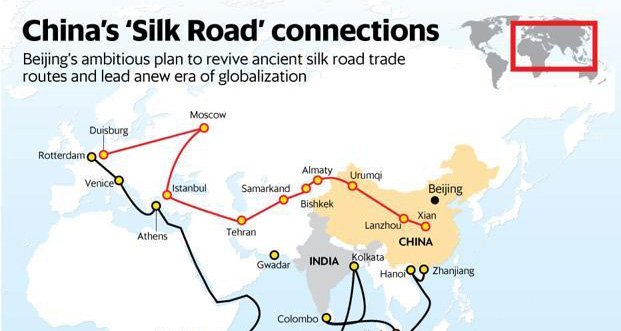Publicité
India’s foray into the Indian Ocean. The only way out?
Par
Partager cet article
India’s foray into the Indian Ocean. The only way out?

This article was published in Weekly No. 290 of 22 March 2018.

Last week, Weekly published the leaked January agreement between India and the Seychelles to build a military base in Assumption Island, one of the numerous islands of the Indian Ocean archipelago. During French President Emmanuel Macron’s visit to India last week, a new Franco-Indian accord also allowed India to use French military bases in the Indian Ocean. Mauritius, on the other hand, signed an agreement with India in 2015 for the building of a jetty and the extension of the airstrip in Agalega, officially for civilian purposes. Weekly investigates the origins of the growing interest of New Delhi in the Indian Ocean region, and the implications for regional geopolitics.
The agreement between the Seychelles and India is valid for 20 years with possibilities to renew it for periods of 10 years. Seychelles President Danny Faure described the agreement as “[attesting] to the kinship and affinity that exists between our two countries”. In Agalega, the Indians are meant to construct a jetty and extend the airstrip, at India’s cost. Concerns have been raised though in regards to the nature – military or civilian – of the infrastructural development on the outer island. Vijay Makhan, former foreign affairs secretary and former deputy secretary general of the Organisation of African Unity (OAU today the African Union), and Arvin Boolell, former minister of foreign affairs, both identify China as the main rival of India and, by extension, the reason for India’s manoeuvres in the Indian Ocean region.
Historically, India has been bordered by the hostile states of Pakistan to the west, and China to the north. Nepal and Bangladesh, traditional allies of India, have, over the recent past, witnessed changes in regimes and in foreign policy, driven by the Chinese One Belt, One Road (OBOR) initiative, which have distanced them from New Delhi. These shifts in allegiance have led former Indian diplomat Amit Dasgupta last month to term the growing Chinese clout in South Asia an “encirclement” of India. “Pakistan is gone. Maldives is about to fall. Nepal is almost there. And Sri Lanka is under an understandable hypnotic trance. India genuinely faces its most serious security challenge,” remarked Dasgupta.
“Nepal has great connectivity with India and an open border […] but we can’t forget that we have two neighbours. We don’t want to depend on one country or have one option.”
The President of the Maldives, Abdulla Yameen, who was elected in 2013, in December backed the OBOR initiative which will see billions of dollars injected into new trade infrastructure by Beijing, much to the dismay of New Delhi. Yameen progressively distanced himself from India amid former president Mohamed Nasheed’s call to India to use force to end the political turmoil which started in 2015 in the island nation. While India urged Yameen to restore constitutional order, China opposed any foreign intervention.
Conversely, Nepal used to be dependent on India and was, up until the fall of the monarchy in 2008 and the creation of a secular republic in 2015, the only officially Hindu state in the world. Its current prime minister, Khadga Prasad Oli, is regarded as being pro-China. In an interview to Hong Kong’s South China Morning Post, Oli stated, “We have great connectivity with India and an open border. All that’s fine and we’ll increase connectivity even further, but we can’t forget that we have two neighbours. We don’t want to depend on one country or have one option.” Oli has since expressed his intention to revive a China-backed $2.5 billion hydropower project, which was abandoned by the previous government, and to improve rail and road network between Nepal and China through Tibet.
Similarly, Bangladesh, born out of a rift with Pakistan when the two countries were one single dominion after Partition of the Indian subcontinent in 1947, is historically closer to India. Bangladesh however has recently enhanced its military cooperation with China too. The latter also announced its financial support to railway projects in Bangladesh and to the transformation of the Payra port into a deep sea one, in line with the OBOR initiative which Bangladesh officially joined in 2016.
One of many Indian moves
The agreements with the Seychelles and Mauritius are among several Indian moves in the Indian Ocean region recently. India previously secured port access in Oman, increased maritime links with the United Arab Emirates and Iran and, most prominently, achieved operational control of the Iranian port of Chahabar. The Indo–Iranian partnership seeks to offset a similar Sino–Pakistani partnership regarding Gwadar Port in the Balochistan Province of Pakistan. Gwadar features eminently in the China–Pakistan Economic Corridor plan, and is regarded as a key link between the Silk Road Economic Belt and the Maritime Silk Road projects of the OBOR initiative. “The development is a clear indicator that India’s geostrategic frontier is expanding in tandem with China’s growing strategic footprint in the Indo-Pacific,” Captain Gurpreet Khurana of the Indian Navy’s National Maritime Foundation said.
The motivation of Indian Ocean countries to cooperate with India also needs to be analysed. Makhan observes that “in this interdependent world, countries have to rely on their neighbours”. For instance, the technical and military help Indian Ocean countries get from India is a tempting incentive. The Seychelles and Mauritius, for instance, have been provided with helicopters, aircraft, naval boats and high-tech coastal surveillance radar systems to perform intelligence gathering missions. India has also been involved in anti-piracy patrols over the years in the waters around the Seychelles and two joint naval operations were held in the Seychelles in 2016 and last month. Besides, Mauritius took part in MILAN 2018, an eight-day biennial “congregation of littoral navies” according to the Indian Ministry of Defence, which took place from 6 to 13 March at the Indian islands of Andaman and Nicobar.
“Encircled by Chinese clout, India seems to be regarding the Indian Ocean as its only way out.”
The latest development came last week when, during French President Emmanuel Macron’s visit to India, a new Franco-Indian accord was signed which allowed each country’s naval forces to use the other’s military bases. Macron declared that “the Indian Ocean, like the Pacific Ocean, cannot be a place of hegemony”, in what is believed to be a reference to China. Indian President Narendra Modi added that the Indian Ocean region would play a “very significant role” in the days to come.
A military scramble for the Indian Ocean?
Could the beefing-up of the Indian military presence in the Indian Ocean cause a military scramble for the region? Both Makhan and Boolell point out that military bases already exist all over the Indian Ocean region. “The USA are present in Diego Garcia, and the French in Reunion and Mayotte,” they both remark. China, on the other hand, opened its first overseas military base in Djibouti last year. Besides, Indian Navy Chief Admiral Sunil Lanba was quoted saying, “We are aware of the Chinese activities in the Indian Ocean region. Their pattern of deployment has remained same since (Sic) many years. At any time, there are 8-10 ships in the Indian Ocean.” Boolell hence warns of the risk of “sparks” the accrued presence of superpowers in the Indian Ocean region could create. The latter however recalls that Mauritius (and the Seychelles) have ratified the Treaty of Pelindaba which establishes a nuclear-weapon-free zone in Africa.
How should Mauritius then react to the growing interests of India and China in the region? Makhan recalls that Mauritius “has always been open” to both countries which are “peopling countries” of Mauritius. He however nuances that cultural and historical links are not the most influential factors in diplomacy. “There are no permanent friendships; only permanent interests,” he says. Boolell also contends that Mauritius ought to adopt a neutral stance in regards to the two Asian powers. “From a realpolitik perspective, we should not punch above our weight,” remarks the former minister, who then concludes, “Yet, we should remain resolutely independent on issues of national interest.”
Encircled by Chinese clout, India seems to be regarding the Indian Ocean as its only way out. The region is the only area where India can still pre-empt China’s ever expanding tentacles. Countries of the Indian Ocean also have genuine military and economic cooperation needs which lead them to positively respond to India’s call. Even if it means triggering a protracted race for influence in the region between Asia’s two superpowers: India and China.
The Chinese One Belt, One Road initiative
<p>Chinese President Xi Jinping announced in 2013 China’s most ambitious foreign policy and economic project, the One Belt, One Road (OBOR) initiative. OBOR comprises a Silk Road Economic Belt, aimed at linking less– developed countries of the Chinese hinterland to China, and a 21st century Maritime Silk Road, looking to connect fast–growing southeast Asian countries to China’s southern provinces by means of ports and railways. Overall, OBOR plans to link Europe to China through Central Asia. OBOR is thus seen to be both geostrategic and geo-economic. The Australian think tank, Lowy Institute, identifies three “pressing challenges” that OBOR will help China meet: “encouraging regional development in China through better integration with neighbouring economies; upgrading Chinese industry while exporting Chinese standards; and addressing the problem of excess capacity.” With OBOR leading to greater Chinese clout in the region, India, China’s rival, has grown more wary of the changes in the status quo.</p>
For more views and in-depth analysis of current issues, Weekly magazine (Price: Rs 25) or subscribe to Weekly for Rs110 a month. (Free delivery to your doorstep). Email us on: weekly@lexpress.mu
Publicité
Publicité
Les plus récents






